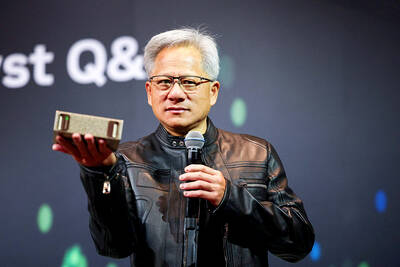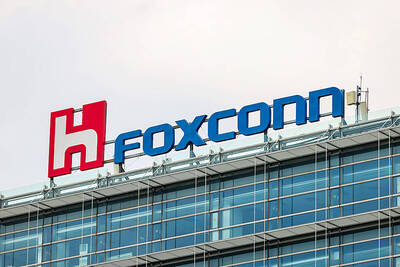MediaTek Inc (聯發科), which supplies handset chips mostly to Chinese brands such as Lenovo Group (聯想), yesterday unveiled its new octo-core chips in Shenzhen, China, a move that analysts said is likely to boost the company’s market share in the world’s biggest mobile phone market.
Daiwa Capital Markets forecast MediaTek’s market share in China’s smartphone chip market to reach 50 percent next year from 48 percent this year.
“Octo-core ICs could become a mainstream staple in China by next year,” Daiwa analyst Eric Chen (陳慧明) said in a report.
Building on the advanced 28-nanometer process, the MT6592 has eight CPU cores, each capable of clocking speeds of up to 2 gigahertz (GHz), according to MediaTek.
The new chip boosts multimedia capabilities and mobile connectivity and it has been adopted by some of the company’s major clients, who plan to launch several smartphones equipped with the chip at the end of this year and next quarter, MediaTek said in a press statement.
“Being the first to market this advanced 8-core system-on-chip is a testament to MediaTek’s industry-leading position,” Jeffrey Ju (朱尚祖), a general manager at MediaTek’s smartphone division, said in the statement.
Chen said the MT6592 chip would help Chinese smartphone makers gain access to the mid and high-end segments and narrow their technology gap with global brands.
It would also help boost orders from global brands, he added.
Rival Qualcomm Inc yesterday downplayed the impact MediaTek’s new chip was likely to have, but declined to comment on whether it would follow MediaTek’s lead and unveil octo-core chip.
“More cores will not make your apps faster. Faster cores will make your apps move faster,” Qualcomm said in a statement.
Qualcomm said it has boosted performance of its new Snapdragon 800 chip by 160 percent, compared with previous Snapdragon 400 chip. These two are both quad-core processors.
Shares in MediaTek ended 2.9 percent lower at NT$419 in Taipei trading yesterday before the announcement of the new chip.
Daiwa maintained a “buy” rating on MediaTek, with a target price of NT$480, implying a 14.56 percent upside.

SEEKING CLARITY: Washington should not adopt measures that create uncertainties for ‘existing semiconductor investments,’ TSMC said referring to its US$165 billion in the US Taiwan Semiconductor Manufacturing Co (TSMC, 台積電) told the US that any future tariffs on Taiwanese semiconductors could reduce demand for chips and derail its pledge to increase its investment in Arizona. “New import restrictions could jeopardize current US leadership in the competitive technology industry and create uncertainties for many committed semiconductor capital projects in the US, including TSMC Arizona’s significant investment plan in Phoenix,” the chipmaker wrote in a letter to the US Department of Commerce. TSMC issued the warning in response to a solicitation for comments by the department on a possible tariff on semiconductor imports by US President Donald Trump’s

‘FAILED EXPORT CONTROLS’: Jensen Huang said that Washington should maximize the speed of AI diffusion, because not doing so would give competitors an advantage Nvidia Corp cofounder and chief executive officer Jensen Huang (黃仁勳) yesterday criticized the US government’s restrictions on exports of artificial intelligence (AI) chips to China, saying that the policy was a failure and would only spur China to accelerate AI development. The export controls gave China the spirit, motivation and government support to accelerate AI development, Huang told reporters at the Computex trade show in Taipei. The competition in China is already intense, given its strong software capabilities, extensive technology ecosystems and work efficiency, he said. “All in all, the export controls were a failure. The facts would suggest it,” he said. “The US

The government has launched a three-pronged strategy to attract local and international talent, aiming to position Taiwan as a new global hub following Nvidia Corp’s announcement that it has chosen Taipei as the site of its Taiwan headquarters. Nvidia cofounder and CEO Jensen Huang (黃仁勳) on Monday last week announced during his keynote speech at the Computex trade show in Taipei that the Nvidia Constellation, the company’s planned Taiwan headquarters, would be located in the Beitou-Shilin Technology Park (北投士林科技園區) in Taipei. Huang’s decision to establish a base in Taiwan is “primarily due to Taiwan’s talent pool and its strength in the semiconductor

French President Emmanuel Macron has expressed gratitude to Hon Hai Precision Industry Co (鴻海精密) for its plan to invest approximately 250 million euros (US$278 million) in a joint venture in France focused on the semiconductor and space industries. On his official X account on Tuesday, Macron thanked Hon Hai, also known globally as Foxconn Technology Group (富士康科技集團), for its investment projects announced at Choose France, a flagship economic summit held on Monday to attract foreign investment. In the post, Macron included a GIF displaying the national flag of the Republic of China (Taiwan), as he did for other foreign investors, including China-based